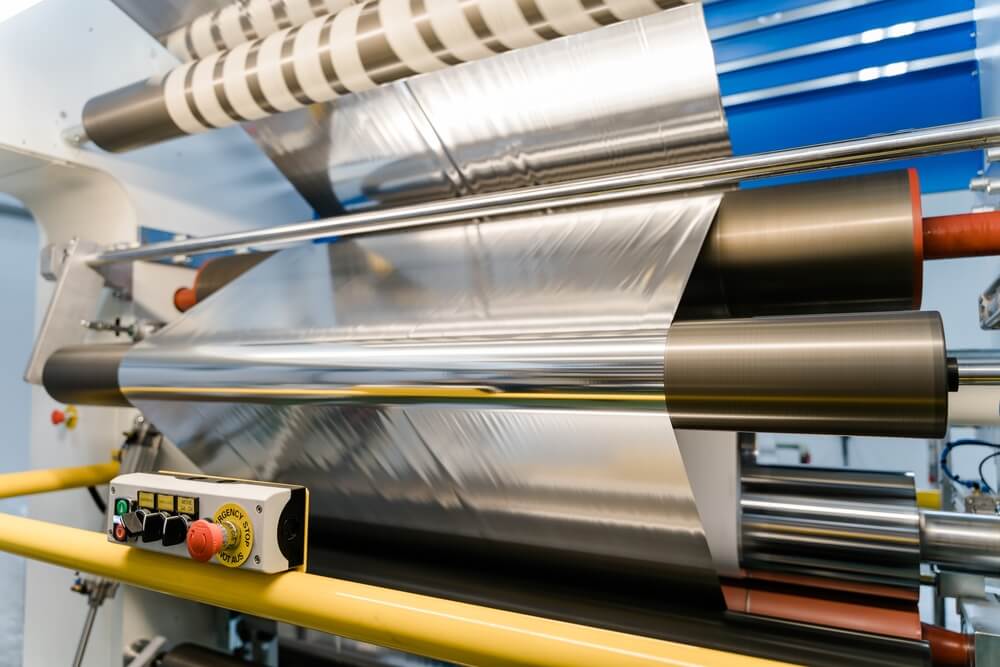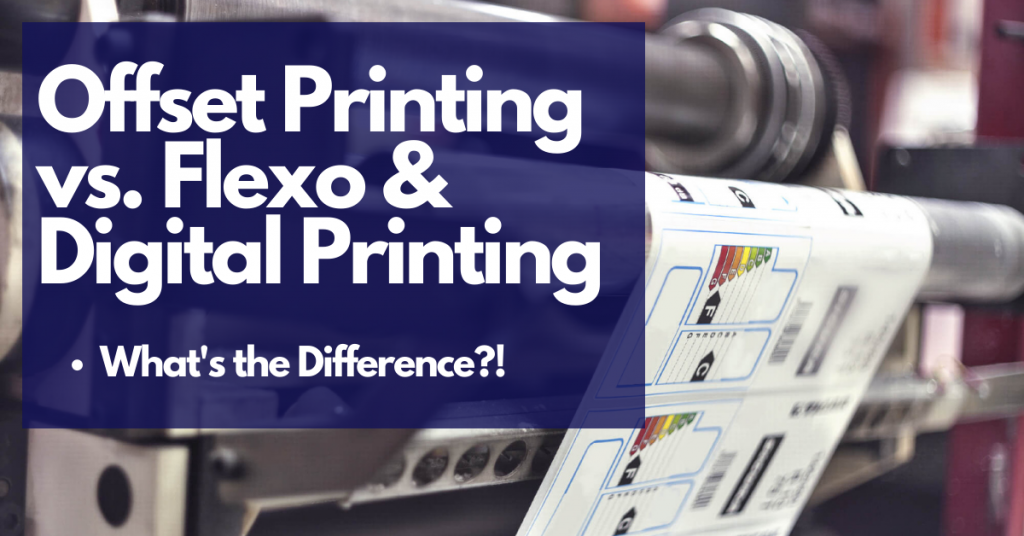A well-branded, high-quality package means choosing the right printing method and technique to best fit your budget, volume, and material requirements.
Here’s the problem: There are so many to choose from!
In today’s post, Complete Packaging Solutions in Brookville, Indiana will help you pick the best one for your business.
TABLE OF CONTENTS:
Printing techniques have come a long way since their inception. Today, there are three primary printing methods: lithography (offset printing), digital, and flexographic printing.
Offset vs. Digital vs. Flexographic Printing
Offset printing is one of the oldest forms of printing (first patented in 1875) and remains till this day a popular way to quickly manufacture custom packages and labels on a large scale.
Flexographic printing is very, very similar to offset but with three major differences: the plates, the ink, and the material it’s printed on.
Digital printing is in a league of its own. It is a cutting-edge, up-and-coming custom package printing method that’s far better suited for small-volume, custom orders.
| Offset Printing | Digital Printing | Flexography |
| Large batch or bulk orders | Great for small batches of printing | Large batches or bulk orders |
| Only prints on smooth surface textures (sheets) | Prints on various surfaces and textures (rolls & sheets) | Prints on various surfaces and textures |
| Cannot apply over-laminates or protective coatings | Can apply protective or Cosmetic finishes or films | Can apply protective finishes and film coatings |
| Less sustainable | More sustainable | Less sustainable |
| Fast runtime | Slower runtime | Fastest runtime |
What’s Offset Printing?
Also known as “offset lithography” printing, this age-old printing method involves ink put on a metal plate which then gets transferred onto a substrate. Offset printing is known for its high quality and low cost. It’s commonly used in creating boxed packaging, books, and magazines.
“Offsetting” is when the image gets transferred from an aluminum plate onto a rubber “blanket” that is then rolled onto the substrate.
This printing method provides vivid prints for small text that digital printing methods do not accomplish. In fact, the brightness and tone of the colors are far better than most other methods: over 500 color variations.
With that in mind, it’s more expensive in shorter run times as a result. It’s a better choice for large order volumes that need to be cranked out in a short amount of time. And once you get started, it’s difficult to change designs or customize.
Pros of Offset Printing:
- Cost-effective for large orders.
- A wide range of materials and laminate coatings can be used.
- Offers a wide range of deeper, richer, and more vibrant color options, including custom inks like metallic and Pantone colors
- Modern offset printers use computer-to-plate, improving accuracy and process time.
Cons of Offset Printing:
- Low-volume printing quickly gets expensive.
- Printing low quantities is time-consuming and costly.
- Edits and proofing are time-consuming and cost inefficient.
- More complex and time-intensive to set up comparatively.
What’s Digital Printing?
It’s often called “copying.” Digital printing has become a hot topic in the media, namely due to gun printing. But it’s just as important in custom package designs.
Pros of Digital Printing:
- Quick and agile for low-volume printing, short run times, and smaller SKUs.
- Fast setup, with no plates to offset or images to change.
- Computerized method, leaving little room for human error.
- More accuracy in proofing, editing, and last-minute design changes.
Obviously, between the two, digital printing is the more expensive choice. But for small batches, short run times, and smaller SKUs, digital printing is actually far cheaper than offset printing.
Digital printing requires very little setup, given the fact that it’s computerized. But it’s not without its shortcomings. Toners and cartridges are, after all, expensive. With large volume printing, the price can skyrocket.
Lastly, digital printing offers variable data printing (VDP) which allows for each printed piece to exchange data to a different sheet. VDP is perfect for creating box packaging that requires different information for each label.
If you had to make this change in offset printing, you’d need a new printing plate for every single label change!
Cons of Digital Printing:
- It can’t print in the PMS Color System (no RGB, only CMYK).
- Slightly lower print quality for ink and color.
- Longer runs cost more money.
- Toner-based digital printers cannot print on white, navy, or black paper.
Digital printing is limited in what materials it can be produced on. Other forms of printing (offset printing) are able to utilize a broader range of materials: corrugated, gray boards, chipboard, or thick sheet paper.
Offset vs Digital Printing: Which Should I Choose?
“How do I choose? Is digital printing or offset printing better?”
Both digital printing and offset printing offer high-quality results.
Bottom line: Offset printing is more economical for producing large batches of packaging, whereas digital printing can provide incredibly complex, customizable, and unique packaging options — perfect for smaller batches.

There are also more coating options available for offset printing. Digital printing does not offer coating options. However, offset printing has cosmetic or protective coats in various forms:
- matte & gloss laminate
- AQ coating
- UV
- Soft touch
What About Flexography Printing?
Alongside digital printing and offset printing comes another notable printing method: flexography or “flexo-printing.” It’s very similar to offset printing and carries with it some of the same drawbacks and benefits.
How it works: It uses a high-speed, mechanical rotary that allows for labels to be printed from a flexible relief plate (rubber or plastic) onto nearly any substrate material (including paper, plastic film, corrugated cardboard, or metallic surfaces).
Flexography vs Offset Printing and Digital Printing
Pros of Flexo-Printing:
Flexo and offset printing overlap heavily. But unlike offset printing, which requires die-cutting, lamination coating, or package folding to be done as a secondary process, flexo-printing does it in a single print cycle.
Flexo-printing also allows you to print directly onto the substrate, rather than printing on a series of offset plates. This makes the print cycle a bit faster.

Unlike digital printing & offset-printing, flexo-printing offers more durable inks and wider variety of vibrant colors (using CMYK colors).
It also allows for more in-line processes like cold foiling and lamination (not possible with digital printing).
Cons of Flexo-Printing:
Simply put: It’s just not as advanced as digital printing, and cannot produce the same level of complex, extensive artistic designs.
It also takes longer to set up. It’s limited in the type of substrates it can print on, and becomes just as expensive and time-consuming as offset printing when creating low-volume packaging orders.

How to Choose the Right Printing Method?
The right choice between digital, flexo, and offset printing comes down to a few variables:
- Volume: How much do you need?
- Color: What range of color gradients or vibrancy would you like?
- Proofs: Need to be able to edit or change things on the fly?
- Material: What substrate material are you looking to print on?
- Time: How long do you want to take with the printing process?
- Customization: Will there be simple or complex design adjustments?
Final Considerations
Historically, offset printing was all the rage. However, due to technological advancement flexographic printing now creates nearly the same level of image quality.
If you really want to get advanced, there’s also hybrid printing. It combines the cost-effectiveness of flexo-printing with the high-speed, computer-aided editing capabilities of digital printing.
Create Your Custom Package Design at Complete Packaging Solutions
Complete Packaging Solutions helps you design, print, package, and ship your product to customers through advanced packaging technologies, including digital printing. Contact us today by calling (765) 547-1300 for more information.

